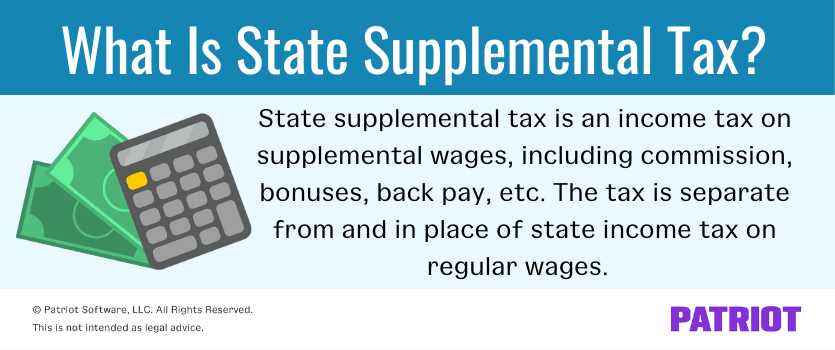What happens when you pay employee commissions or bonuses? You may need to use a supplemental flat tax rate for federal and state income taxes. Not all states require supplemental tax rates. So, take a look at the supplemental tax rates by state to see if your state does.
What is supplemental tax?
Before we get into the supplemental tax rates by state, let’s review supplemental income tax. Supplemental income tax is assessed on supplemental wages (e.g., bonuses, commissions, etc.). The federal supplemental withholding tax is 22%.
The supplemental income tax is not in addition to standard income tax rates. Instead, you use the supplemental rate in place of the standard withholding rate.
Social Security and Medicare tax rates do not change on supplemental wages.
What is a state supplemental income tax?
State income tax is a tax on an employee’s wages. The state determines how much tax to withhold for income tax and the method of withholding. Some states may use a progressive method where the tax increases as wages increase. Others choose to use a flat tax rate where all wages receive the same tax rate.
Employers do not use the supplemental wage tax rate for standard wages, such as hourly or salaried work. Instead, employers use state supplemental tax rates when paying wages that supplement an employee’s standard income. Examples of supplemental income include:
- Bonuses
- Commission pay
- Awards
- Prizes
- Back pay
- Retro pay increases
- Overtime pay
- Payments for accrued sick leave
- Paid time off or vacation payouts
- Severance pay

Do employers have to use a supplemental tax rate?
State laws may vary, but employers typically can decide to use supplemental tax rates. But there’s a catch. In some states, the use of the supplemental tax rate can depend on how you pay the employee’s supplemental pay.
- Paying supplemental wages separately: If you pay your employee separately from their standard wages (e.g., a second payroll run for commission pay), use the supplemental tax rate for the commission payroll. You can use the supplemental tax rate if you withheld income tax from regular wages during the same year or the previous year.
- Paying supplemental wages with standard wages: If you pay an employee their supplemental and regular wages together in the same payroll and don’t separately state the wages on your payroll records, do not use the supplemental tax rate. Instead, process payroll and taxes as usual.
Not all states follow the same rules regarding how to pay supplemental wages and tax them. Check with your state for more information.
Do supplemental tax rates change?
While the federal supplemental tax rate has remained 22% for years, state supplemental tax rates may change each year.
Because tax rates may change every year, remember that the pay date determines tax liability.
For example, you decide to pay an employee for their unused vacation time at the end of the year. But you set the pay date for January 4. Because the pay date is in the following year, you must use the new year’s tax rate for the payout. And the wages will go on the following year’s Form W-2.
Supplemental tax rates by state
State supplemental tax rates depend on a few factors. First, only states with income tax withholding use supplemental tax rates. But, not all of them use supplemental withholding rates even if they have state income tax. Instead, states without supplemental income tax rates continue using their standard income tax methods on supplemental pay.
States that do not have income tax include:
- Alaska
- Florida
- Nevada
- New Hampshire
- South Dakota
- Tennessee
- Texas
- Washington
- Wyoming
The states with income tax and no supplemental tax rate include:
- Arizona
- Colorado
- Connecticut
- Delaware*
- Hawaii
- Idaho
- Illinois
- Indiana
- Kentucky
- Louisiana
- Massachusetts
- Michigan
- Mississippi
- New Jersey
- Pennsylvania
- South Carolina
- Utah
- Washington, D.C.
States with supplemental income tax rates include:
- Alabama
- Arkansas
- California
- Georgia
- Iowa
- Kansas
- Maine
- Maryland
- Minnesota
- Missouri
- Montana
- Nebraska
- New Mexico
- New York
- North Carolina
- North Dakota
- Ohio
- Oklahoma
- Oregon
- Rhode Island
- Vermont
- Virginia
- West Virginia
- Wisconsin
Check out this chart for supplemental tax rates by state:
| State | Supplemental Tax Rate (2024) |
|---|---|
| Alabama | 5.0% |
| Alaska | No state income tax |
| Arizona | None |
| Arkansas | 4.4% |
| California | 10.23% on bonus and stock options, 6.6% on all else |
| Colorado | None |
| Connecticut | None |
| Delaware | None (but the state recommends 5% withholding for deferred compensation payments) |
| Florida | No state income tax |
| Georgia | Varies by annual wage amount Under $8,000: 2.0% $8,000 – $10,000: 3.0% $10,000.01 – $12,000: 4.0% $12,000.01 – $15,000: 5.0% Over $15,000: 5.49% |
| Hawaii | None |
| Idaho | None |
| Illinois | None |
| Indiana | None |
| Iowa | 6.0% |
| Kansas | 5.0% |
| Kentucky | None |
| Louisiana | None |
| Maine | 5.0% |
| Maryland | Use the rate at the bottom of the local tax table (3.2% for Maryland residents working in Delaware and other nonreciprocal states) |
| Massachusetts | None |
| Michigan | None |
| Minnesota | 6.25% |
| Mississippi | None |
| Missouri | 4.8% |
| Montana | 5.0% |
| Nebraska | 5.0% |
| Nevada | No state income tax |
| New Hampshire | No state income tax |
| New Jersey | None |
| New Mexico | 5.9% |
| New York | 11.7% |
| North Carolina | 4.6% |
| North Dakota | 1.5% |
| Ohio | 3.5% |
| Oklahoma | 4.75% |
| Oregon | 8% |
| Pennsylvania | None |
| Rhode Island | 5.99% |
| South Carolina | None |
| South Dakota | No state income tax |
| Tennessee | No state income tax |
| Texas | No state income tax |
| Utah | None |
| Vermont | 30% of federal withholding, or 6% for payments under a nonqualified deferred compensation plan |
| Virginia | 5.75% |
| Washington | No state income tax |
| Washington, D.C. | None |
| West Virginia | Varies by annual gross salary amount Under $10,000: 2.36% $10,000 – $25,000: 3.15% $25,000.01 – $40,000: 3.54% $40,000.01 – $60,000: 4.72% Over $60,000: 5.12% |
| Wisconsin | Varies by annual gross salary amount Under $12,760: 3.54% $12,760 – $25,520: 4.65% $25,520.01 – $280,950: 5.30% Over $280,950: 7.65% |
| Wyoming | No state income tax |
Keep in mind that your locality might have a separate supplemental tax rate. For example, New York City’s supplemental tax rate is 4.25%. Check with your local tax authority for more information.
Contact your state for the most up-to-date tax rates.
Example of supplemental tax rates
You have a business in Kansas and pay an employee a bonus of $500. The bonus pay is on a separate payroll from the employee’s wages, so you must use the supplemental tax rate.
The federal supplemental tax rate is 22%. Kansas has a state supplemental tax rate of 5%. Social Security remains 6.2%, and Medicare is still 1.45%.
Multiply the $500 bonus by 22% to determine how much to withhold for federal income tax (FIT):
$500 X 22% = $110
Then, multiply $500 by 5% to calculate the Kansas supplemental tax:
$500 X 5% = $25
Determine Social Security tax withholding by multiplying the bonus pay by 6.2%:
$500 X 6.2% = $31
Multiply $500 by 1.45% to get Medicare withholding:
$500 X 1.45% = $7.25
Subtract all of the tax withholding amounts from the gross bonus pay amount to determine the employee’s bonus net pay:
Net Pay = Gross – FIT – SIT – Social Security – Medicare
$326.75 = $500 – $110 – $25 – $31 – $7.25
After calculating the supplemental pay rate, the employee’s net pay is $326.75.
This article has been updated from its original publication date of January 24, 2022.
This is not intended as legal advice; for more information, please click here.


